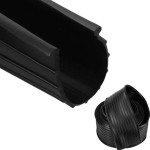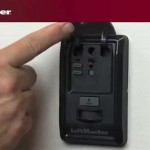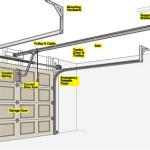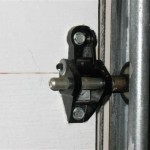Garage Door Weather Stripping: Understanding 16 Ft Options
Garage door weather stripping plays a crucial role in maintaining the energy efficiency, security, and overall integrity of a home or building. A properly installed weather strip effectively seals the gap between the garage door and the door frame or ground, preventing air infiltration, water damage, and pest intrusion. For many standard-sized residential garage doors, a 16-foot length of weather stripping is a common requirement. This article provides a comprehensive overview of garage door weather stripping, focusing on 16 ft options, including the different types available, factors to consider when selecting a product, installation tips, and maintenance recommendations.
The function of garage door weather stripping extends beyond simply blocking drafts. It contributes to temperature regulation within the garage, which can impact the comfort of adjacent living spaces and the efficiency of heating and cooling systems. By preventing the exchange of air between the garage and the outdoors, weather stripping helps to reduce energy consumption and lower utility bills. Furthermore, it protects stored items in the garage from moisture damage and deters pests from entering, thereby safeguarding personal belongings and maintaining a cleaner environment.
Beyond the practical benefits, garage door weather stripping also serves an aesthetic purpose. A clean, well-maintained weather strip enhances the overall appearance of the garage door and contributes to the curb appeal of the property. Replacing worn or damaged weather stripping can instantly improve the look of the garage door and give it a refreshed appearance.
Types of Garage Door Weather Stripping
Garage door weather stripping is available in a variety of materials and designs, each offering different levels of performance and durability. Choosing the right type of weather stripping depends on several factors, including the type of garage door, the climate in which it is located, and the budget of the homeowner. Understanding the characteristics of each type is essential for making an informed decision.
Vinyl Weather Stripping: Vinyl is one of the most commonly used materials for garage door weather stripping due to its affordability and ease of installation. It is relatively resistant to moisture and temperature changes, making it suitable for a wide range of climates. Vinyl weather stripping typically comes in rolls and can be easily cut to fit the required length. However, vinyl can become brittle and crack over time, especially in extreme temperatures, which may require periodic replacement. Different profiles are available, including J-shape, P-shape, and T-shape, each designed for specific door configurations.
Rubber Weather Stripping: Rubber weather stripping offers superior durability and resistance to wear and tear compared to vinyl. It is more flexible and less prone to cracking, making it a good choice for areas with harsh weather conditions. Rubber is also more resistant to chemicals and solvents, which can extend its lifespan. However, rubber weather stripping tends to be more expensive than vinyl. Similar to vinyl, it comes in various shapes and sizes to accommodate different garage door designs. EPDM rubber is a popular choice, known for its excellent resistance to ozone, ultraviolet light, and weathering.
Silicone Weather Stripping: Silicone weather stripping provides excellent sealing properties and is highly resistant to temperature extremes. It remains flexible even in very cold temperatures, making it a suitable option for regions with harsh winters. Silicone is also resistant to UV radiation and ozone, which helps to prolong its lifespan. However, silicone weather stripping is generally more expensive than both vinyl and rubber options. Its flexibility and durability make it a premium choice for demanding applications.
Brush Weather Stripping: Unlike the previous types, brush weather stripping consists of a brush-like strip that creates a seal by conforming to uneven surfaces. It is particularly effective for sealing gaps at the bottom of the garage door, especially on uneven floors. Brush weather stripping is typically made of nylon or polypropylene bristles and is mounted on an aluminum or steel carrier. It is durable and resistant to wear, making it a long-lasting option. Brush weather stripping is also effective at preventing dust and debris from entering the garage.
Aluminum and Vinyl Combination Weather Stripping: This type of weather stripping combines the strength of aluminum with the sealing properties of vinyl. The aluminum provides a rigid backing for the vinyl strip, making it more durable and resistant to damage. This combination is often used for the top and sides of the garage door frame. The aluminum can be painted to match the color of the garage door, enhancing its aesthetic appeal.
Factors to Consider When Selecting 16 Ft Weather Stripping
Choosing the right weather stripping for a 16 ft garage door involves considering several factors to ensure optimal performance and longevity. The climate, garage door type, budget, and desired level of insulation all play a role in the selection process. Carefully evaluating these factors will help in making an informed decision that meets specific needs and requirements.
Climate: The local climate is a significant factor to consider when selecting weather stripping. In regions with extreme temperatures, rubber or silicone weather stripping is recommended due to its superior resistance to cracking and degradation. In areas with heavy rainfall or snow, weather stripping with excellent water resistance is essential to prevent moisture damage. Coastal areas may require weather stripping that is resistant to salt air corrosion. Evaluating the specific climate conditions will help in choosing a weather stripping material that can withstand the elements.
Garage Door Type: The type of garage door also influences the choice of weather stripping. Different types of garage doors, such as sectional doors, roll-up doors, and tilt-up doors, have different sealing requirements. Sectional doors typically require weather stripping along the top, sides, and bottom of the door, while roll-up doors may only need weather stripping at the bottom. Matching the weather stripping profile to the garage door type is crucial for achieving a proper seal.
Budget: The budget is always a factor in any home improvement project. While higher-quality weather stripping may offer better performance and durability, it also comes at a higher cost. Vinyl weather stripping is generally the most affordable option, while silicone and aluminum/vinyl combinations are more expensive. Balancing the budget with the desired level of performance and longevity is important. Consider the long-term cost savings of investing in a more durable weather stripping material that requires less frequent replacement.
Ease of Installation: The ease of installation is another factor to consider, especially for homeowners who prefer to do the project themselves. Some types of weather stripping are easier to install than others. Vinyl and rubber weather stripping can often be installed using basic tools, while other types may require more specialized equipment. If professional installation is preferred, the cost of labor should also be factored into the budget.
Desired Level of Insulation: The desired level of insulation is important to consider for homeowners looking to improve the energy efficiency of their garage. Weather stripping with a higher R-value provides better insulation, helping to reduce heat loss in the winter and heat gain in the summer. Rubber and silicone weather stripping generally offer better insulation than vinyl. Consider the overall insulation of the garage, including the walls and ceiling, to determine the appropriate level of insulation for the weather stripping.
Installation Tips for 16 Ft Garage Door Weather Stripping
Proper installation of garage door weather stripping is essential for achieving optimal performance and longevity. Careful preparation, accurate measurements, and attention to detail are crucial for ensuring a tight and effective seal. Following these installation tips will help to achieve a professional-quality result.
Preparation: Begin by cleaning the area where the weather stripping will be installed. Remove any old weather stripping, dirt, debris, or rust. Use a scraper, wire brush, or solvent to clean the surface thoroughly. Ensure that the surface is dry and free of any oil or grease. This will allow the new weather stripping to adhere properly.
Measurement and Cutting: Accurately measure the length of the garage door frame or door panel where the weather stripping will be installed. Use a measuring tape and mark the required length on the weather stripping. Use a sharp utility knife or scissors to cut the weather stripping to the correct length. Cutting the weather stripping precisely will ensure a snug fit and prevent gaps.
Installation Methods: Depending on the type of weather stripping, there are several installation methods to choose from. Some weather stripping comes with pre-applied adhesive backing, while others require nails, screws, or staples. Follow the manufacturer's instructions carefully to ensure proper installation. For adhesive-backed weather stripping, peel off the backing and press the weather stripping firmly against the surface. For weather stripping that requires fasteners, use the appropriate type of nail, screw, or staple and space them evenly along the length of the weather stripping.
Sealing Corners and Joints: Pay close attention to corners and joints, as these are common areas for air leaks. Cut the weather stripping at a 45-degree angle to create a mitered corner. This will provide a seamless seal between the weather stripping sections. Use a sealant or caulk to fill any small gaps or cracks. This will help to prevent air and water from entering the garage.
Testing the Seal: After installing the weather stripping, test the seal by closing the garage door and checking for any gaps or air leaks. Use a flashlight to shine light around the edges of the door and look for any light seeping through. If any gaps are found, adjust the weather stripping or add additional sealant to create a tighter seal. Ensuring a tight seal will maximize the energy efficiency and protection of the garage.
Safety Precautions: Always wear safety glasses and gloves when installing garage door weather stripping. Use caution when using sharp tools, such as utility knives and scissors. If working on a ladder, ensure that it is stable and secure. Disconnect the garage door opener before starting any work to prevent accidental operation of the door.
By carefully following these installation tips, homeowners can successfully install 16 ft garage door weather stripping and achieve a tight, effective seal that protects their garage from the elements. Regular inspection and maintenance will help to prolong the lifespan of the weather stripping and ensure continued performance.

Garage Door Threshold Seal 16 Ft

16 Ft Weatherstripping At Lowes Com

Climaloc Garage Door Weather Strip Aluminium And Vinyl 16 Ft Cf21180 Rona

Frost King 16 Ft Garage Door Bottom Seal Kit 2 1 4 In G16h The Home

Vevor Garage Door Seals Bottom Rubber U Shape O Ring Combination Weather Stripping With Pre Drilled Aluminum Track Retainer Kit 5 16 Inch T Ends And 3 4 Width Ft Black

Garage Door Seal Weather Stripping Kit Rubber Insulation 16ft T End Dust Barrier Ebay

16 Ft Garage Door Weatherstripping Gray Walmart Com

18 Years Factory 16 Foot Insulated Garage Door Bottom Weather Seal Replacement Kit Bestar

Frost King 16 Ft Garage Door Bottom Seal Kit 2 1 4 In G16h The Home

Pemko P365v16 Garage And Overhead Door Bottom Trademark Hardware
See Also








